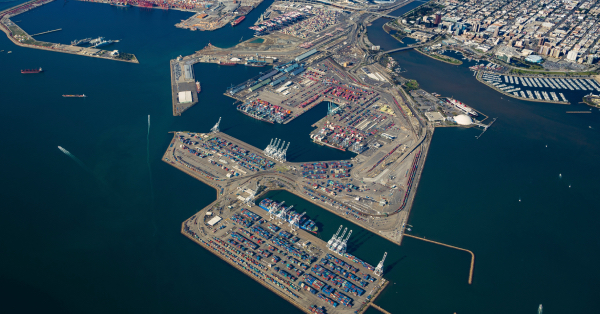In the perennial tug-of-war between West Coast and East Coast ports, the momentum has shifted yet again. Imports from Asia are starting to head back to America’s Pacific gateways.
East and Gulf Coast ports increased their market share in the years prior to the pandemic as the expanded Panama Canal allowed more cost-effective shipping service to Eastern states, which boast the highest population of consumers.
Asian cargo flows shifted toward Los Angeles and Long Beach, California, in the early stages of the pandemic due to shorter transit times. Then, after congestion clogged those ports, the pendulum swung back to the East. That trend was accelerated in the first half of this year by concerns over West Coast port labor unrest.
Now, the labor issue is resolved, Panama Canal water levels are restricting capacity utilization on transiting container ships bound for East and Gulf Coast ports, and both spot rate data and import data imply the West Coast is regaining some lost ground.
Spot rate trends diverge by coast
Trans-Pacific spot rates to both coasts have fallen double-digits from August’s peak-season highs, but rates to the West Coast have held up better than rates to the East Coast. The West Coast route has retained much more of the peak-season rate run-up that began July 1 and peaked in the third week of August.
This spot-rate differential is a positive indicator on volume flows to the West Coast, to the extent it’s not caused by differing levels of “blanked” (canceled) sailings to each coastline.
According to the Freightos Baltic Daily Index (FBX), China-West Coast rates averaged $1,563 per forty-foot equivalent unit on Friday, up 31% from June 30. In contrast, the FBX assessment of China-East Coast rates, at $2,213 per FEU on Friday, was essentially flat (up 1%) versus June 30.
The Drewry World Container Index (WCI) put average Shanghai-to-Los Angeles spot rates at $1,961 per FEU for the week ending Thursday, still up 19% from the week ending June 29, prior to the seasonal upswing.
The WCI put average Shanghai-to-New York rates at $2,552 per FEU in the latest week — all the way back down to late-June levels.
Import volume trends diverge by coast
Independent analyst John McCown compiles data on imports to the top U.S. ports and analyzes volume trends.
“September had East/Gulf Coast ports underperforming West Coast ports for the second straight month, coming behind a streak of 26 straight months where the East/Gulf Coast ports overperformed,” McCown wrote in his latest monthly report.
Inbound volume at the top East and Gulf Coast ports fell 13.4% year on year (y/y) in September, while West Coast volumes rose 16.7%, equating to a 30.1-percentage-point spread in favor of the West Coast. The spread in August was 11.4 points in favor of the West Coast.
In contrast, the spread over the past 28 months averaged 11.3 points in favor of East/Gulf Coast ports.
McCown also analyzed the sequential coastal shift by looking at three-month trailing average volumes. This average heavily favored the East/Gulf Coast ports from mid-2021 through this August, but has now reversed.
“In September, based on the trailing three-month figures, that difference flipped to the West Coast ports’ advantage [at a spread] of 8.2 percentage points,” said McCown.
The nascent reversal of fortunes in the West Coast market is apparent in the latest monthly stats of the ports of Los Angeles and Long Beach.
Long Beach posted its best September ever in terms of overall throughput, with imports up 19.3% y/y. Long Angeles’ imports rose 14.3% y/y.
Los Angeles expects imports to remain healthy through the fourth quarter, with full-year throughput now predicted to be down 13% y/y. “That’s an unbelievably good comeback given that we were down 32% in Q1,” said Port of Los Angeles Executive Director Gene Seroka in a press conference on Oct. 23.
Seroka pointed to the improving market share of West Coast ports in recent months. “With more cargo coming back to the West Coast, it basically gets us back to where we were [in terms of coastal market share] prior to the port labor negotiations.”
Source: Freight Waves









































